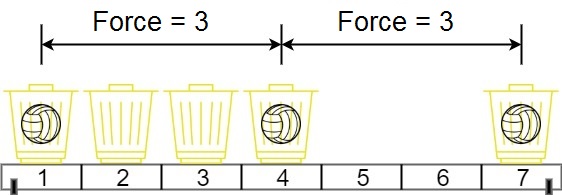- {x}
- Make The String Great
- Find Kth Bit in Nth Binary String
- Maximum Number of Non-Overlapping Subarrays With Sum Equals Target
- Minimum Cost to Cut a Stick
- The Most Similar Path in a Graph
- The Most Recent Orders for Each Product
- Three Consecutive Odds
- Minimum Operations to Make Array Equal
- Magnetic Force Between Two Balls
- Minimum Number of Days to Eat N Oranges
- Strings Differ by One Character
- Bank Account Summary
- Thousand Separator
- Minimum Number of Vertices to Reach All Nodes
- Minimum Numbers of Function Calls to Make Target Array
- Detect Cycles in 2D Grid
- Most Visited Sector in a Circular Track
- Read More...

Magnetic Force Between Two Balls
In the universe Earth C-137, Rick discovered a special form of magnetic force between two balls if they are put in his new invented basket. Rick has n empty baskets, the ith basket is at position[i], Morty has m balls and needs to distribute the balls into the baskets such that the minimum magnetic force between any two balls is maximum.
Rick stated that magnetic force between two different balls at positions x and y is |x - y|.
Given the integer array position and the integer m. Return the required force.
Example 1:

Input: position = [1,2,3,4,7], m = 3 Output: 3 Explanation: Distributing the 3 balls into baskets 1, 4 and 7 will make the magnetic force between ball pairs [3, 3, 6]. The minimum magnetic force is 3. We cannot achieve a larger minimum magnetic force than 3.
Example 2:
Input: position = [5,4,3,2,1,1000000000], m = 2 Output: 999999999 Explanation: We can use baskets 1 and 1000000000.
Constraints:
n == position.length2 <= n <= 1051 <= position[i] <= 109- All integers in
positionare distinct. 2 <= m <= position.length
Solution Explanation: Magnetic Force Between Two Balls
This problem asks to find the maximum minimum magnetic force between any two balls when distributing m balls into n baskets located at positions given in the position array. The magnetic force between two balls is the absolute difference of their positions.
The core idea is to use binary search. The problem exhibits monotonicity: a larger minimum force implies fewer balls can be placed. Therefore, we can efficiently search for the maximum minimum force using binary search.
Algorithm:
-
Sort: Sort the
positionarray in ascending order. This is crucial for efficiently checking if a given minimum force is achievable. -
Binary Search: Perform a binary search on the range of possible minimum forces.
- The lower bound is 1 (minimum possible force).
- The upper bound is the maximum difference between consecutive positions in the sorted array (or the difference between the last and first positions for simplicity).
-
Check Feasibility (count function): In each iteration of the binary search, we need to check if a given minimum force (
f) is achievable. This is done using a helper functioncount(f).count(f)iterates through the sortedpositionarray.- It keeps track of the last placed ball's position (
prev). - For each position, it checks if the distance to the last placed ball (
curr - prev) is greater than or equal tof. If it is, a ball can be placed at this position, incrementing thecnt(number of balls placed). count(f)returns the total number of balls that can be placed with a minimum force off.
-
Binary Search Logic:
- If
count(mid)(wheremidis the midpoint in the binary search) is greater than or equal tom, it means we can placemballs with a minimum force of at leastmid. So, we update the lower bound (l) tomid. - Otherwise, we update the upper bound (
r) tomid - 1.
- If
-
Result: The final value of
lafter the binary search represents the maximum minimum magnetic force achievable.
Time Complexity: O(n log n + n log M), where n is the number of baskets and M is the range of positions (approximately the maximum position value). The O(n log n) comes from sorting, and O(n log M) comes from the binary search and the count function called in each iteration.
Space Complexity: O(log n) due to the recursive calls in the binary search (in some implementations). If the sorting algorithm uses in-place sorting, space complexity could be considered O(1)
Code Examples (Python):
import bisect
class Solution:
def maxDistance(self, position: List[int], m: int) -> int:
def check(f: int) -> bool:
prev = -float('inf')
cnt = 0
for curr in position:
if curr - prev >= f:
prev = curr
cnt += 1
return cnt >= m #changed to >= for correctness
position.sort()
l, r = 1, position[-1] - position[0] # improved upper bound
ans = 0
while l <= r:
mid = (l + r) // 2
if check(mid):
ans = mid
l = mid + 1
else:
r = mid - 1
return ans
This Python code directly implements the binary search. The check function efficiently determines feasibility. The upper bound of the binary search is improved to position[-1] - position[0]. This prevents unnecessary iterations.
Other languages (Java, C++, Go, TypeScript, JavaScript) follow a similar structure, adapting the syntax and data structures accordingly. The core logic of binary search and the feasibility check remains consistent.